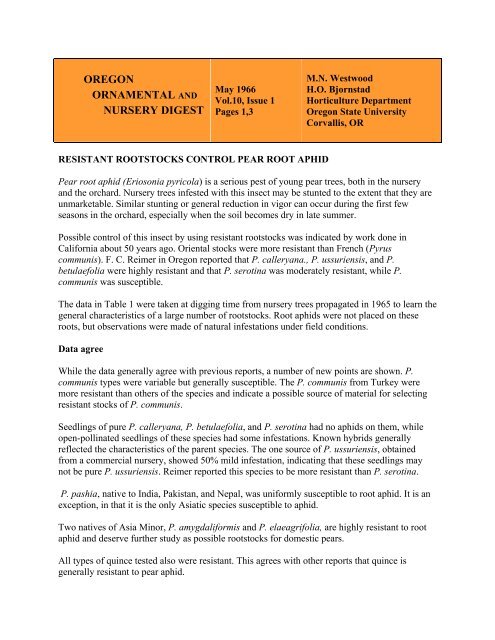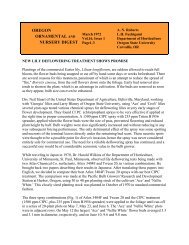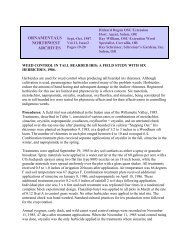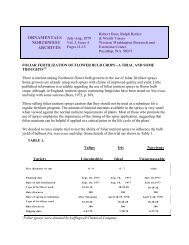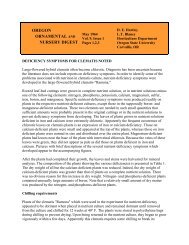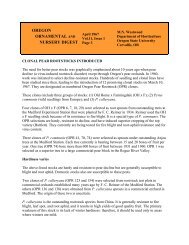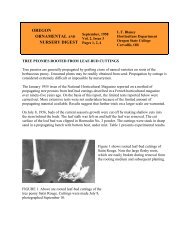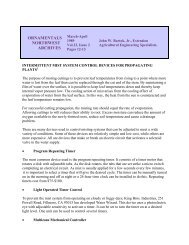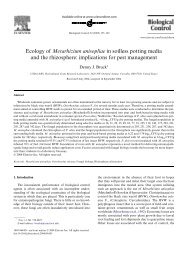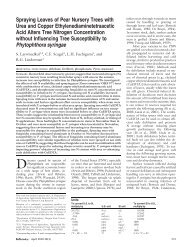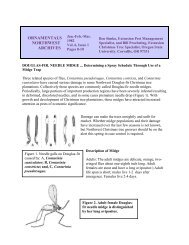Resistant Rootstocks Control Pear Root Aphid, Vol.10, Issue 1
Resistant Rootstocks Control Pear Root Aphid, Vol.10, Issue 1
Resistant Rootstocks Control Pear Root Aphid, Vol.10, Issue 1
Create successful ePaper yourself
Turn your PDF publications into a flip-book with our unique Google optimized e-Paper software.
OREGON<br />
ORNAMENTAL AND<br />
NURSERY DIGEST<br />
May 1966<br />
<strong>Vol.10</strong>, <strong>Issue</strong> 1<br />
Pages 1,3<br />
M.N. Westwood<br />
H.O. Bjornstad<br />
Horticulture Department<br />
Oregon State University<br />
Corvallis, OR<br />
RESISTANT ROOTSTOCKS CONTROL PEAR ROOT APHID<br />
<strong>Pear</strong> root aphid (Eriosonia pyricola) is a serious pest of young pear trees, both in the nursery<br />
and the orchard. Nursery trees infested with this insect may be stunted to the extent that they are<br />
unmarketable. Similar stunting or general reduction in vigor can occur during the first few<br />
seasons in the orchard, especially when the soil becomes dry in late summer.<br />
Possible control of this insect by using resistant rootstocks was indicated by work done in<br />
California about 50 years ago. Oriental stocks were more resistant than French (Pyrus<br />
communis). F. C. Reimer in Oregon reported that P. calleryana., P. ussuriensis, and P.<br />
betulaefolia were highly resistant and that P. serotina was moderately resistant, while P.<br />
communis was susceptible.<br />
The data in Table 1 were taken at digging time from nursery trees propagated in 1965 to learn the<br />
general characteristics of a large number of rootstocks. <strong>Root</strong> aphids were not placed on these<br />
roots, but observations were made of natural infestations under field conditions.<br />
Data agree<br />
While the data generally agree with previous reports, a number of new points are shown. P.<br />
communis types were variable but generally susceptible. The P. communis from Turkey were<br />
more resistant than others of the species and indicate a possible source of material for selecting<br />
resistant stocks of P. communis.<br />
Seedlings of pure P. calleryana, P. betulaefolia, and P. serotina had no aphids on them, while<br />
open-pollinated seedlings of these species had some infestations. Known hybrids generally<br />
reflected the characteristics of the parent species. The one source of P. ussuriensis, obtained<br />
from a commercial nursery, showed 50% mild infestation, indicating that these seedlings may<br />
not be pure P. ussuriensis. Reimer reported this species to be more resistant than P. serotina.<br />
P. pashia, native to India, Pakistan, and Nepal, was uniformly susceptible to root aphid. It is an<br />
exception, in that it is the only Asiatic species susceptible to aphid.<br />
Two natives of Asia Minor, P. amygdaliformis and P. elaeagrifolia, are highly resistant to root<br />
aphid and deserve further study as possible rootstocks for domestic pears.<br />
All types of quince tested also were resistant. This agrees with other reports that quince is<br />
generally resistant to pear aphid.
Table 1. Infestation of several Pyrus rootstocks with pear root aphid (Corvallis research<br />
Nursery, 1965)<br />
<strong>Root</strong>stock<br />
Number<br />
Of trees<br />
None<br />
%<br />
<strong>Root</strong> aphid<br />
nfestation:<br />
Mild<br />
%<br />
Moderate<br />
%<br />
Severe<br />
%<br />
P. communis:<br />
Medford Station sprouts . ---------------------------- 54 50 50 0 0<br />
Old Home x Farmingdale ---------------------------- 100 58 33 0 9<br />
Domestic French --------------------------------------<br />
Imported French (Europe) --------------------------<br />
352<br />
205<br />
30<br />
44<br />
35<br />
38<br />
17<br />
12<br />
18<br />
6<br />
P. communis (Turkey) --..----------------- --------- 31 80 20 0 0<br />
Special Hartman seedlings--------------- 34 10 50 0 40<br />
P. calleryana:<br />
Source A─pure ------ ----------------------------<br />
30 100 0 0 0<br />
Source B ─open pollinated ----------------------------- 19 75 25 0 0<br />
Source C─open pollinated --------------------------- 12 67 33 0 0<br />
C. P. type ─ source unknown ------------------------ 11 73 27 0 0<br />
P. betulaefoiia:<br />
Medford Station─pure ---------------------------- 40 100 0 0 0<br />
Medford Station─ open pollinated ----------------- 100 62 38 0 0<br />
Italy─open pollinated -------- ------------------------- 138 33 67 0 0<br />
Other species:<br />
P. ussuriensis (P. C.) ----------------------------<br />
68 50 50 0 0<br />
P. pashia ---------------------------------------------- 48 0 50 50 0<br />
P. phaeocarpa --------------------------------------- 4 50 50 0 0<br />
P. serotina --------------------------------------------.<br />
P. amvgdaliformis ........----------------------------------<br />
4<br />
178<br />
100<br />
100<br />
0<br />
0<br />
0<br />
0<br />
0<br />
0<br />
P. elaeagrifolia -------------------------------------<br />
Cvdonia oblonga (quince) --------------------- .<br />
33<br />
48<br />
100<br />
100<br />
0<br />
0<br />
0<br />
0<br />
0<br />
0<br />
Hybrids<br />
P betulaefolia x P communis -------------------- 35 17 66 17 0<br />
P. betulaefolia x P. calleryana ------------------- 18 67 33 0 0<br />
P. canescens x P. betulaefolia ------------------- 41 50 50 0 0<br />
P. canescens x P. communis ----------------------- 57 0 75 25 0<br />
P. canescens x P. calleryana. --------------------- 55 50 50 0 0<br />
P. canescens x open pollinated -------------------- 18 0 0 100 0<br />
P. calleryana x P. communis ----------------------- 10 100 0 0 0<br />
P. longipe─open pollinated ---------------------- 29 33 67 0 0<br />
A few seedlings of two other pear stocks appeared to be resistant to root aphid. One is the<br />
Korean wild pear, P. fauriei, and the other is P. syriaca, a native of Israel. Little is known of<br />
these species as rootstocks, and further work must be done to determine their possible value.<br />
It should be pointed out that two of the aphid-resistant stocks, P. ussuriensis and P. serotina, are<br />
highly susceptible to pear decline and should not be used as rootstocks.
Other more detailed studies on pear root aphid are being carried out at OSU by the<br />
Department of Entomology. Dr. Knud Swenson is studying the life cycle of the insect as it is<br />
affected by the environment. Dr. Peter Westigard at the Southern Oregon Experiment Station,<br />
Medford, is using root pieces of different pear species to study root resistance to aphid feeding<br />
under controlled conditions.<br />
Oregon Ornamental and Nursery Digest was published from 1957 to 1975 by the Agricultural Experiment Station,<br />
Oregon State University, Corvallis.<br />
Pesticide Use - Due to constantly changing laws and regulations, no liability for the suggested use of chemicals in<br />
this reprint is assumed. Pesticides should be applied according to label directions on the pesticide container.<br />
Permission to Reprint material appearing in the Oregon Ornamental and Nursery Digest is granted with the request<br />
that you credit the source: Oregon Ornamental and Nursery Digest, date, volume, issue, page numbers. Do not<br />
excerpt or reprint in such a manner as to imply the author's endorsement or criticism of a product or concept.<br />
Nondiscrimination - The information in the Oregon Ornamental and Nursery Digest is provided with the<br />
understanding that no discrimination is intended and that listing of commercial products implies no endorsement by<br />
the authors. Criticism of products or equipment is neither intended nor implied.


